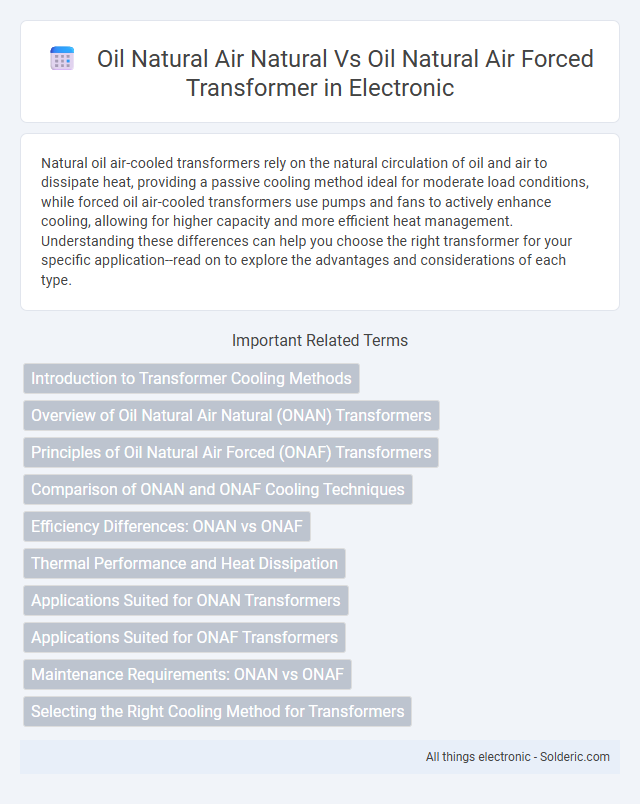Natural oil air-cooled transformers rely on the natural circulation of oil and air to dissipate heat, providing a passive cooling method ideal for moderate load conditions, while forced oil air-cooled transformers use pumps and fans to actively enhance cooling, allowing for higher capacity and more efficient heat management. Understanding these differences can help you choose the right transformer for your specific application--read on to explore the advantages and considerations of each type.
Comparison Table
| Feature | Oil Natural Air Natural (ONAN) | Oil Natural Air Forced (ONAF) |
|---|---|---|
| Cooling Method | Oil circulates naturally; air cools naturally | Oil circulates naturally; air is forced by fans |
| Cooling Efficiency | Moderate | High |
| Cooling Capacity | Suitable for low to medium load | Suitable for high load and increased heat dissipation |
| Noise Level | Low (no fans) | Higher (fan operation noise) |
| Maintenance | Lower (no fans) | Higher (fan maintenance required) |
| Application | Small to medium transformers | Large transformers requiring enhanced cooling |
| Cost | Lower initial and operational cost | Higher due to fans and controls |
Introduction to Transformer Cooling Methods
Transformer cooling methods include natural air cooling and forced air cooling, both essential for maintaining optimal operating temperatures. Natural air-cooled transformers rely on ambient air circulation to dissipate heat, suitable for lower load capacities and environments with moderate heat buildup. In contrast, forced air cooling uses fans to increase airflow, enhancing heat transfer efficiency and enabling higher power ratings and improved reliability in demanding applications.
Overview of Oil Natural Air Natural (ONAN) Transformers
Oil Natural Air Natural (ONAN) transformers rely on natural convection for cooling, where the heat generated by the transformer's core and windings causes the surrounding oil to circulate without pumps, transferring heat to the surrounding air. This efficient, passive cooling method ensures reliability and reduces operational costs by eliminating the need for mechanical cooling devices. Commonly used in distribution and power transformers, ONAN designs provide a balance of performance and simplicity for moderate load and temperature conditions.
Principles of Oil Natural Air Forced (ONAF) Transformers
Oil Natural Air Forced (ONAF) transformers operate by using natural convection to circulate insulating oil inside the transformer tank, which absorbs heat from the core and windings. The heated oil then transfers this heat to external radiators where forced air circulation, powered by fans, enhances cooling efficiency. This combination improves thermal regulation and allows ONAF transformers to handle higher loads compared to Oil Natural Air Natural (ONAN) designs.
Comparison of ONAN and ONAF Cooling Techniques
ONAN (Oil Natural Air Natural) transformers rely on natural convection where both oil circulation and air cooling occur without external assistance, resulting in lower cooling efficiency suitable for moderate load conditions. ONAF (Oil Natural Air Forced) transformers use fans to enhance air flow over the radiator fins, significantly improving heat dissipation and enabling higher load capacities and better temperature control. Choosing ONAF can optimize your transformer's performance under demanding operational environments by maintaining lower operating temperatures and extending equipment life.
Efficiency Differences: ONAN vs ONAF
Oil Natural Air Natural (ONAN) transformers rely on natural convection for cooling, resulting in moderate efficiency suitable for steady, low-load conditions. Oil Natural Air Forced (ONAF) transformers employ fans to enhance air circulation, significantly improving heat dissipation and allowing higher loading capacity with better efficiency under variable or heavy load scenarios. The forced cooling in ONAF reduces operational losses and maintains optimal temperature, thereby extending transformer lifespan and reducing energy consumption compared to ONAN models.
Thermal Performance and Heat Dissipation
Natural air natural oil (NANO) transformers rely on the passive circulation of oil and ambient air for cooling, resulting in moderate thermal performance suited for lower load conditions. In contrast, natural air forced oil (NAFO) transformers enhance heat dissipation by incorporating fans or blowers that increase airflow around the radiators, significantly improving cooling efficiency. This forced cooling allows NAFO transformers to handle higher thermal loads, extend equipment life, and maintain optimal operating temperatures under more demanding conditions.
Applications Suited for ONAN Transformers
ONAN transformers, characterized by their Oil Natural Air Natural cooling method, are ideal for applications with moderate load requirements and stable ambient temperatures where natural convection suffices for heat dissipation. These transformers are commonly used in distribution networks, renewable energy integrations like solar and wind farms, and industrial facilities requiring reliable and maintenance-friendly operation. Their design supports environments lacking forced ventilation systems, making them cost-effective choices for rural or less industrialized areas.
Applications Suited for ONAF Transformers
ONAF (Oil Natural Air Forced) transformers are ideal for industrial applications requiring enhanced cooling under moderate to heavy load conditions, such as power plants, manufacturing facilities, and large HVAC systems. These transformers efficiently manage heat dissipation through natural oil circulation combined with forced air cooling, making them suitable for environments with fluctuating electrical demands. Their design supports reliability and longer service life in settings where temperature control is critical to maintaining transformer performance.
Maintenance Requirements: ONAN vs ONAF
ONAN transformers rely on natural air circulation and oil convection for cooling, resulting in lower maintenance requirements due to fewer mechanical components and simpler cooling systems. ONAF transformers incorporate forced air cooling with fans, necessitating regular inspection, cleaning, and potential replacement of fan units, increasing maintenance complexity. The enhanced cooling capacity of ONAF units supports higher load ratings but demands more rigorous upkeep to ensure optimal performance and reliability.
Selecting the Right Cooling Method for Transformers
Choosing between oil natural air natural (ONAN) and oil natural air forced (ONAF) transformer cooling methods depends on your transformer's load and ambient conditions. ONAN cooling relies on natural circulation of oil and air, providing efficient heat dissipation for standard load applications, while ONAF incorporates fans to boost airflow, enhancing cooling capacity for higher loads or elevated temperatures. Selecting the right method ensures optimal transformer performance, prolonging equipment life and preventing overheating under varying operational demands.
oil natural air natural vs oil natural air forced transformer Infographic

 solderic.com
solderic.com